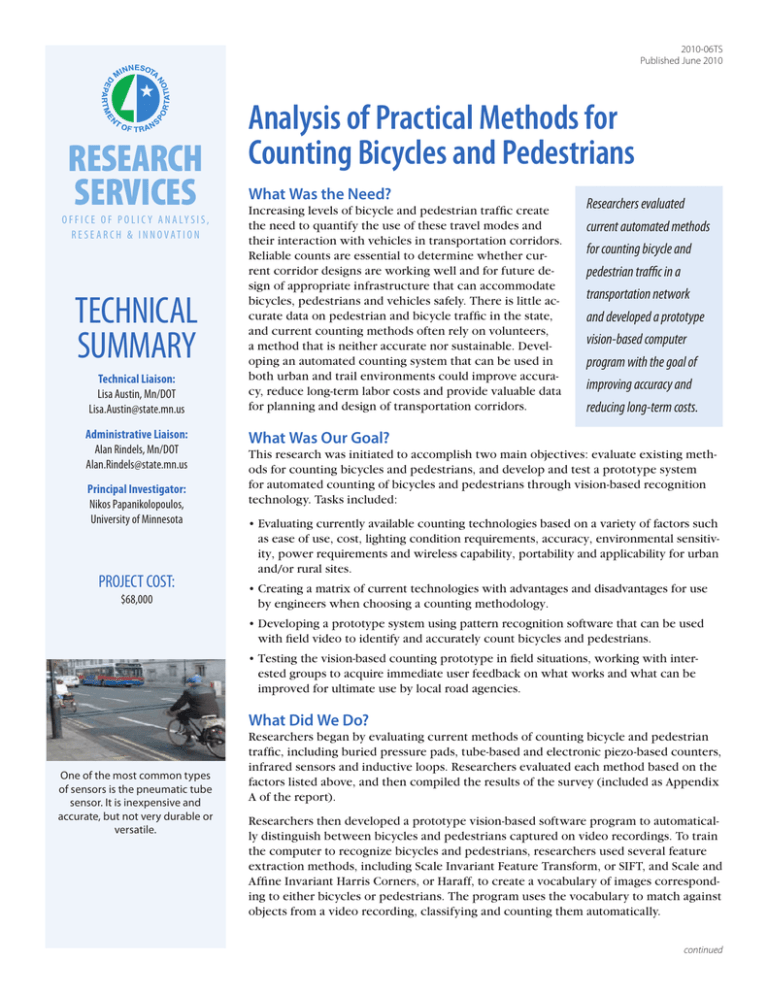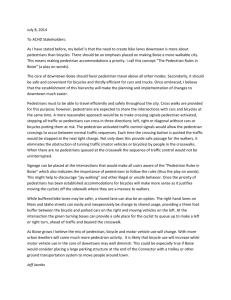RESEARCH SERVICES Analysis of Practical Methods for Counting Bicycles and Pedestrians
advertisement

2010-06TS Published June 2010 RESEARCH SERVICES O F F I C E O F P O L I C Y A N A LY S I S , R E SE A R C H & I N N OVAT I O N TECHNICAL SUMMARY Technical Liaison: Lisa Austin, Mn/DOT Lisa.Austin@state.mn.us Administrative Liaison: Alan Rindels, Mn/DOT Alan.Rindels@state.mn.us Principal Investigator: Nikos Papanikolopoulos, University of Minnesota PROJECT COST: $68,000 Analysis of Practical Methods for Counting Bicycles and Pedestrians What Was the Need? Increasing levels of bicycle and pedestrian traffic create the need to quantify the use of these travel modes and their interaction with vehicles in transportation corridors. Reliable counts are essential to determine whether current corridor designs are working well and for future design of appropriate infrastructure that can accommodate bicycles, pedestrians and vehicles safely. There is little accurate data on pedestrian and bicycle traffic in the state, and current counting methods often rely on volunteers, a method that is neither accurate nor sustainable. Developing an automated counting system that can be used in both urban and trail environments could improve accuracy, reduce long-term labor costs and provide valuable data for planning and design of transportation corridors. Researchers evaluated current automated methods for counting bicycle and pedestrian traffic in a transportation network and developed a prototype vision-based computer program with the goal of improving accuracy and reducing long-term costs. What Was Our Goal? This research was initiated to accomplish two main objectives: evaluate existing methods for counting bicycles and pedestrians, and develop and test a prototype system for automated counting of bicycles and pedestrians through vision-based recognition technology. Tasks included: • Evaluating currently available counting technologies based on a variety of factors such as ease of use, cost, lighting condition requirements, accuracy, environmental sensitivity, power requirements and wireless capability, portability and applicability for urban and/or rural sites. • Creating a matrix of current technologies with advantages and disadvantages for use by engineers when choosing a counting methodology. • Developing a prototype system using pattern recognition software that can be used with field video to identify and accurately count bicycles and pedestrians. • Testing the vision-based counting prototype in field situations, working with interested groups to acquire immediate user feedback on what works and what can be improved for ultimate use by local road agencies. What Did We Do? One of the most common types of sensors is the pneumatic tube sensor. It is inexpensive and accurate, but not very durable or versatile. Researchers began by evaluating current methods of counting bicycle and pedestrian traffic, including buried pressure pads, tube-based and electronic piezo-based counters, infrared sensors and inductive loops. Researchers evaluated each method based on the factors listed above, and then compiled the results of the survey (included as Appendix A of the report). Researchers then developed a prototype vision-based software program to automatically distinguish between bicycles and pedestrians captured on video recordings. To train the computer to recognize bicycles and pedestrians, researchers used several feature extraction methods, including Scale Invariant Feature Transform, or SIFT, and Scale and Affine Invariant Harris Corners, or Haraff, to create a vocabulary of images corresponding to either bicycles or pedestrians. The program uses the vocabulary to match against objects from a video recording, classifying and counting them automatically. continued “There is not a lot of data out there regarding bicycle and pedestrian counts. An accurate system that can be used on trails as well as urban environments would be very helpful, and the system developed here has a lot of potential.” –Lisa Austin, A vocabulary of objects was constructed from images of bicycles and pedestrians using both SIFT and Haraff features. Mn/DOT Bicycle and Pedestrian Planner The software was then tested in the field. Researchers used a handheld camcorder mounted on a tripod to capture more than 10 hours of video from five locations. Instead of physically observing a trail or path, manually counting each bicycle or pedestrian who passed, the captured video was transferred to a computer and analyzed by the software program, automatically creating counts of bicycles and pedestrians. “The biggest advantage of computer visionbased counting is the verifiability of results that is not possible with other methods. When a bicycle or a pedestrian is detected in a video and counted, it can be archived and verified manually in the future.” During the course of the project, researchers worked with volunteers from local community groups who were performing manual counts. Researchers conducted a training session for dozens of people from a variety of groups to demonstrate how to use the new vision-based counting system. –Nikos Papanikolopoulos, University of Minnesota Department of Computer Science and Engineering Produced by CTC & Associates for: Minnesota Department of Transportation Research Services Section MS 330, First Floor 395 John Ireland Blvd. St. Paul, MN 55155-1899 (651) 366-3780 www.research.dot.state.mn.us What Did We Learn? Researchers found that each of the 11 counting methods currently in use has limitations. No method evaluated was able to count both bicycles and pedestrians with a high degree of accuracy. For example, commonly used tube counters are very accurate, portable and inexpensive, but these cannot be used to count pedestrians. Infrared and radio beam sensors can theoretically be used to count both pedestrians and bicycles, but accuracy is affected by riders or walkers crossing the sensors parallel to one another. The table comparing available technologies will help engineers choose the best counting method for differing situations. While testing the prototype video system, researchers discovered that community and business groups were very interested in an accurate, inexpensive and flexible program for counting bicycle and pedestrian use of transportation networks. Researchers established relationships and built good will between Mn/DOT and the communities where the work was done. The prototype system demonstrated potential, but also some difficulties. The system was able to count bicycles and pedestrians from the video recordings, but accuracy and functionality need to be improved before it can be used commercially. Researchers learned that for this type of counting methodology, the system must be tuned to the requirements of a specific location, and that counting pedestrians, bicycles and vehicles at the same time is still a difficult proposition. What’s Next? A second phase of this project is being funded by the Intelligent Transportation Systems Institute, a part of the Center for Transportation Studies at the University of Minnesota. This phase will be completed over the next 16 months and aims to improve the accuracy, flexibility and functionality of the prototype developed for this project, and may ultimately lead to a viable product that could be used by Mn/DOT. This Technical Summary pertains to Report 2010-06, “Analysis of Practical Methods for Analyzing Pedestrian and Bicycle Use of a Transportation Facility,” published February 2010. The full report can be accessed at http://www.lrrb.org/PDF/201006.pdf.





